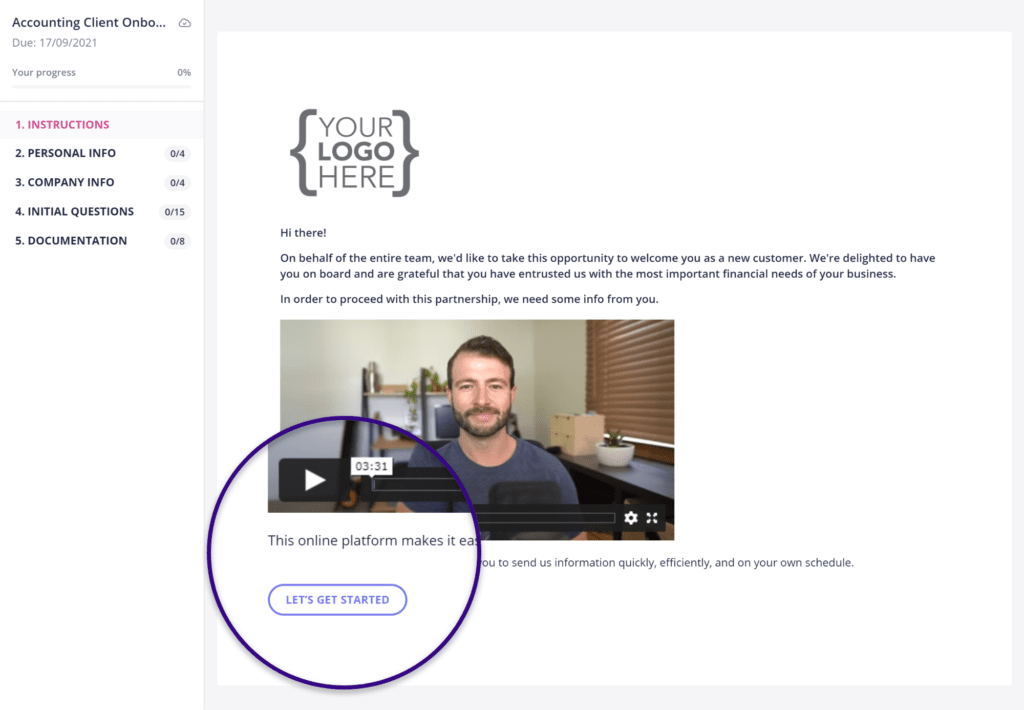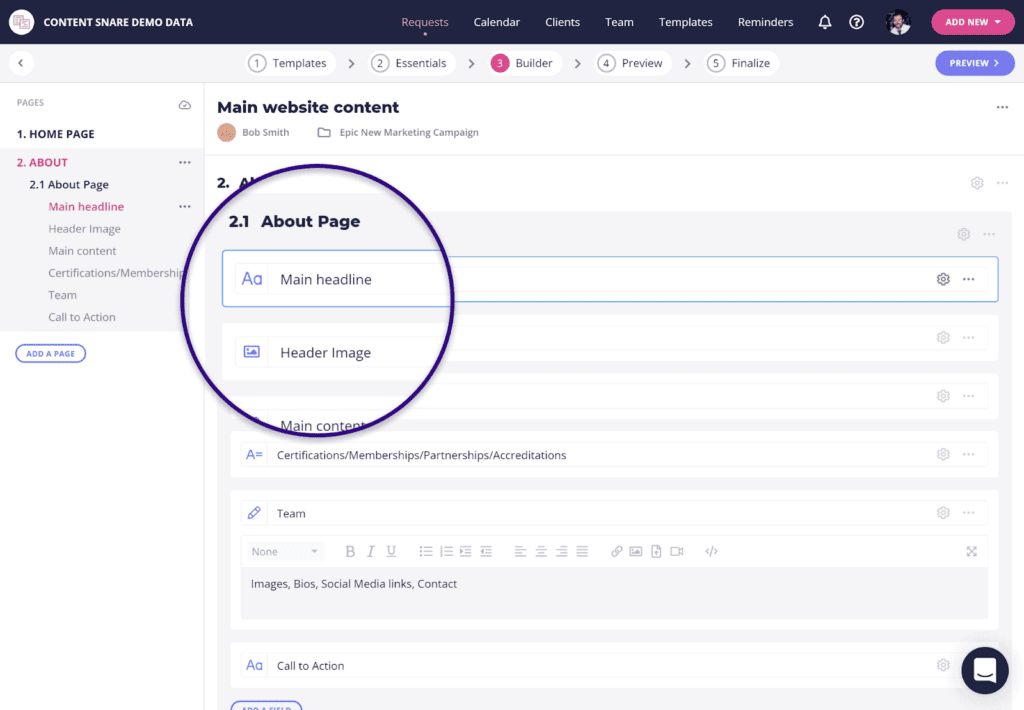Big ups! You just sealed the deal with a new client you worked hard to get.
You might be buzzing with excitement or nerves (probably both) because chances are that despite all this hype… you’re terrified that you might blow it.
The sales process is only the beginning of the journey with your new client. Your next task is to build a strong relationship with them and make sure that they feel valued through every stage of your collaboration.
So how can you start your client relationship off on the right foot and ensure long-term success?
In short, you need to put some time aside to develop your client onboarding strategy (or client onboarding process). Get this process right and you’ll easily be able to prove yourself as a professional they’ll want to work with long-term.
Here are 5 client onboarding best practices you can implement to begin with a bang and set your client up for success, whatever type of business you’re in.

5 client onboarding best practices for any business
1. Send a warm welcome email or host a welcome get-together
It’s always worth putting a little bit of effort into a formal welcome to make your new clients feel valued. How you do this will depend on your product or service and industry.
For some, it can mean crafting a welcome email.
Need step-by-step instructions on how to do this? Here’s how to write a new client welcome email.
Just looking for a few helpful tips on what to include? Here are a few:
- Thank the client for choosing to work with you.
- Remind them why you’re the right choice to help them solve their problems.
- Share your values and what they can expect to see while working with you.
- Let them know what to expect next in their client onboarding experience.
If you work in a more one-on-one industry (let’s say you’re a personal trainer or realtor), a welcome email might not be your cup of tea. To deliver a more personalized experience, you can host a simple get-together or treat your client to dinner to share the same ideas in-person.
It’s up to you to decide what works best for you. Either way, a formal welcome is a great way to enhance the client experience and show your new clients that you appreciate their business.

2. Re-confirm client expectations and desired outcomes
Sales cycles can take weeks or months. So much can change between your initial meetings and the day you get to work!
Our biggest tip for a successful client onboarding process is to check in with your client one more time in the initial stages to see if expectations, desired outcomes, or priorities have changed.
If you’re an agency handling digital marketing for a client in an industry that pivots often and quickly, there’s a chance your client’s priorities have shifted since you last spoke. You might need to allocate your resources to put out a PR fire or get a new product launch out the door before you redesign their website.
Or if you’re an event planner for a wedding, your client might have come across some new inspiration which may take your project in a different direction than you first discussed.
Whatever industry you’re in, this is one of the top client onboarding best practices you can implement to manage client expectations for project success and show your new clients that you don’t let anything slip through the cracks.

3. Set a communication cadence
The next step for client onboarding success is to discuss how, when, and where you’ll be communicating with your new client and what you expect from them as you work together.
Here are a few things to cover regarding client communication:
Assign a central point of contact
Introduce your new client to your customer success manager or customer success team. If you don’t have a support team, put them in touch with whoever’s best suited to address the client’s needs as the project unfolds. That way, your client will know who they need to check in with.
Choose a preferred communication channel
Having different conversations with your client on multiple different platforms is a recipe for disaster! Agree on a chosen platform, be that strictly over email, by phone, or Slack. This gets everyone on the same page and helps you avoid having new clients contact you in the wrong places (like your personal insta DMs… god forbid).

Create a communication schedule
We all know how painful it can be to wait weeks for approvals, decisions, or any feedback at all. Or worse.. receiving 6 AM calls from a client who regularly forgets that you’re in a different timezone.
Ask that your new clients give your feedback on your deliverables within 24 or 36 hours. Let them know whether you’ll be in touch with them daily, weekly, bi-weekly, or monthly with an update. All of this will clarify working expectations and help your collaboration run like a well-oiled machine.
4. Use a data collection tool to gather everything you need
Before you begin your work, you’ll no doubt need to collect things like information, assets, and project files from your new client. A very easy way to both impress them and make your own life easier is to build a client onboarding questionnaire using a tool like Content Snare.

Dedicated software like this is built to help you avoid things like:
- Having to chase your client for information over email for weeks
- Receiving information scattered across tons of separate emails
- Running into attachment size limitations over email
- Only realizing they sent you the wrong files when you’re about to start the project
Good client onboarding software helps you collect everything in one place, includes automatic reminders to nudge them to send you what you need, and even lets you reject or approve content as you receive it.
Including data collection software in your onboarding process is one of those things you’ll thank yourself for!
Big fan of automating your processes with software? Here’s a list of 15 client onboarding tools to boost efficiency.
5. Ask for feedback, early
A smart thing to do in the onboarding stage is to put a feedback system in place. Don’t wait until the end of a project to find out what you could have done better. Send your new clients a feedback survey mid-way through your work to help gauge clients satisfaction. You can even use the same software we mentioned above to send feedback surveys too.
Including a feedback system in your onboarding process shows that you care to do better, and can pivot to meet client expectations. When clients see that you have a client-centric approach, you’re far more likely to ensure an ongoing relationship with them.
Why should I take time to develop my client onboarding process?
Here are a few reasons why the client onboarding process (or client onboarding strategy) is so important:
1. The entire experience matters to clients
It’s not just about your deliverables; your clients care about what it feels like to work with you. A good client onboarding process helps take care of your clients to make them feel valued and supported every step of the way, right from the beginning.
2. Good client onboarding = better client success
A successful onboarding process leads to client success. It’s an incredible way to identify and solve potential problems early on to guarantee that there are fewer hiccups on the way and that projects meet client expectations.
3. Effective client onboarding helps reduce churn rate
Did you know that it costs five times more to acquire a new client than to retain an existing one? (Harvard Business Review). With that in mind, it only makes sense to optimize any processes that can increase the chances of long-term relationships and turn clients into repeat customers..
4. Good client onboarding helps you bring in more business
Properly onboarding clients is an easy way to make a good first impression, stand out among your competitors, and earn yourself a positive reputation. When you do a good job at it, satisfied clients will remember what it was like to work with you and be very likely to refer you new business.

A final tip for client onboarding success
We hope these client onboarding strategies have given you some inspiration for what good client onboarding can look like.
Don’t forget that like with any process, you’ll need to keep improving it.
As you go through your journey with new clients, make a list of what needs improvement, and re-work it as many times as it takes to get your onboarding process to a 10/10!
Get the tools you need to streamline your onboarding process
Enhance your client experience and save plenty of time when you use modern software to collect everything you need from your clients. Content Snare simplifies your client onboarding process by collecting client assets and project files from your clients, and can even help you gather feedback and approvals too.



